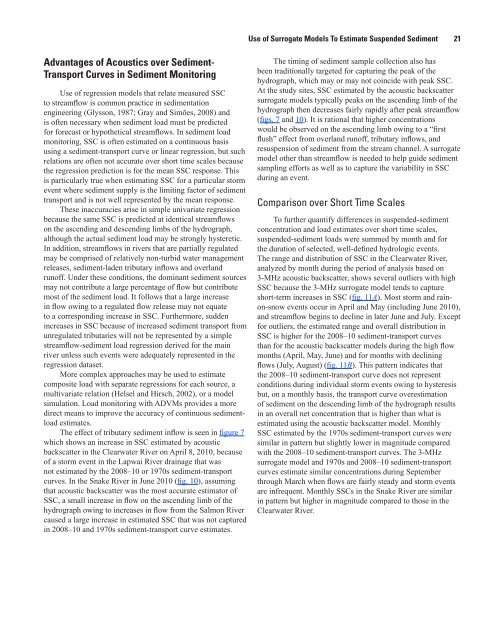Report PDF (3.7 MB) - USGS
Report PDF (3.7 MB) - USGS
Report PDF (3.7 MB) - USGS
You also want an ePaper? Increase the reach of your titles
YUMPU automatically turns print PDFs into web optimized ePapers that Google loves.
Use of Surrogate Models To Estimate Suspended Sediment 21<br />
Advantages of Acoustics over Sediment-<br />
Transport Curves in Sediment Monitoring<br />
Use of regression models that relate measured SSC<br />
to streamflow is common practice in sedimentation<br />
engineering (Glysson, 1987; Gray and Simões, 2008) and<br />
is often necessary when sediment load must be predicted<br />
for forecast or hypothetical streamflows. In sediment load<br />
monitoring, SSC is often estimated on a continuous basis<br />
using a sediment-transport curve or linear regression, but such<br />
relations are often not accurate over short time scales because<br />
the regression prediction is for the mean SSC response. This<br />
is particularly true when estimating SSC for a particular storm<br />
event where sediment supply is the limiting factor of sediment<br />
transport and is not well represented by the mean response.<br />
These inaccuracies arise in simple univariate regression<br />
because the same SSC is predicted at identical streamflows<br />
on the ascending and descending limbs of the hydrograph,<br />
although the actual sediment load may be strongly hysteretic.<br />
In addition, streamflows in rivers that are partially regulated<br />
may be comprised of relatively non-turbid water management<br />
releases, sediment-laden tributary inflows and overland<br />
runoff. Under these conditions, the dominant sediment sources<br />
may not contribute a large percentage of flow but contribute<br />
most of the sediment load. It follows that a large increase<br />
in flow owing to a regulated flow release may not equate<br />
to a corresponding increase in SSC. Furthermore, sudden<br />
increases in SSC because of increased sediment transport from<br />
unregulated tributaries will not be represented by a simple<br />
streamflow-sediment load regression derived for the main<br />
river unless such events were adequately represented in the<br />
regression dataset.<br />
More complex approaches may be used to estimate<br />
composite load with separate regressions for each source, a<br />
multivariate relation (Helsel and Hirsch, 2002), or a model<br />
simulation. Load monitoring with ADVMs provides a more<br />
direct means to improve the accuracy of continuous sedimentload<br />
estimates.<br />
The effect of tributary sediment inflow is seen in figure 7<br />
which shows an increase in SSC estimated by acoustic<br />
backscatter in the Clearwater River on April 8, 2010, because<br />
of a storm event in the Lapwai River drainage that was<br />
not estimated by the 2008–10 or 1970s sediment-transport<br />
curves. In the Snake River in June 2010 (fig. 10), assuming<br />
that acoustic backscatter was the most accurate estimator of<br />
SSC, a small increase in flow on the ascending limb of the<br />
hydrograph owing to increases in flow from the Salmon River<br />
caused a large increase in estimated SSC that was not captured<br />
in 2008–10 and 1970s sediment-transport curve estimates.<br />
The timing of sediment sample collection also has<br />
been traditionally targeted for capturing the peak of the<br />
hydrograph, which may or may not coincide with peak SSC.<br />
At the study sites, SSC estimated by the acoustic backscatter<br />
surrogate models typically peaks on the ascending limb of the<br />
hydrograph then decreases fairly rapidly after peak streamflow<br />
(figs. 7 and 10). It is rational that higher concentrations<br />
would be observed on the ascending limb owing to a “first<br />
flush” effect from overland runoff, tributary inflows, and<br />
resuspension of sediment from the stream channel. A surrogate<br />
model other than streamflow is needed to help guide sediment<br />
sampling efforts as well as to capture the variability in SSC<br />
during an event.<br />
Comparison over Short Time Scales<br />
To further quantify differences in suspended-sediment<br />
concentration and load estimates over short time scales,<br />
suspended-sediment loads were summed by month and for<br />
the duration of selected, well-defined hydrologic events.<br />
The range and distribution of SSC in the Clearwater River,<br />
analyzed by month during the period of analysis based on<br />
3-MHz acoustic backscatter, shows several outliers with high<br />
SSC because the 3-MHz surrogate model tends to capture<br />
short-term increases in SSC (fig. 11A). Most storm and rainon-snow<br />
events occur in April and May (including June 2010),<br />
and streamflow begins to decline in later June and July. Except<br />
for outliers, the estimated range and overall distribution in<br />
SSC is higher for the 2008–10 sediment-transport curves<br />
than for the acoustic backscatter models during the high flow<br />
months (April, May, June) and for months with declining<br />
flows (July, August) (fig. 11B). This pattern indicates that<br />
the 2008–10 sediment-transport curve does not represent<br />
conditions during individual storm events owing to hysteresis<br />
but, on a monthly basis, the transport curve overestimation<br />
of sediment on the descending limb of the hydrograph results<br />
in an overall net concentration that is higher than what is<br />
estimated using the acoustic backscatter model. Monthly<br />
SSC estimated by the 1970s sediment-transport curves were<br />
similar in pattern but slightly lower in magnitude compared<br />
with the 2008–10 sediment-transport curves. The 3-MHz<br />
surrogate model and 1970s and 2008–10 sediment-transport<br />
curves estimate similar concentrations during September<br />
through March when flows are fairly steady and storm events<br />
are infrequent. Monthly SSCs in the Snake River are similar<br />
in pattern but higher in magnitude compared to those in the<br />
Clearwater River.
















